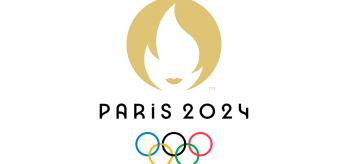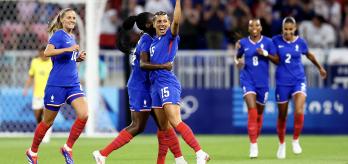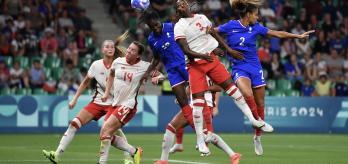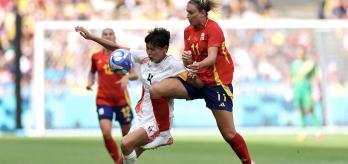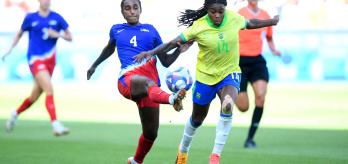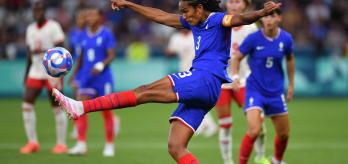Hervé Renard’s side powered to a 3-0 half-time lead with an enthralling style of attacking football. The speed of their offensive play was a product of the incessant player movement and rotations, consistent offers to receive, positive first touches of the ball and well-crafted overloads in wide areas.
According to Anna Signeul, “This was an eye-catching first-half performance from France in so many ways. The team cohesion and players’ understanding of their roles in different moments of the attacking phases was really impressive. They looked like a focused team that really knew what they wanted to do and had the technical ability and tactical intelligence to generate fast, powerful attacks that really distorted Colombia’s defence.
“They stretched their opponent using width and depth, and their three midfielders were incredibly proactive and industrious in helping their progressions into the final third. The movements in tandem with the front three and two full-backs were really well orchestrated and it was clear they had worked hard on these patterns in training,” she explained.
Use of wide areas
Two key characteristics of France’s attacking display included their ability to create overloads in wide areas, and how efficient they were at getting additional players into the penalty area as options to get on the end of different types of crosses.
During moments of their build-up play where the ball was played into the wide channels, France’s midfield three, comprised of defensive midfielder Sandie Toletti (14) and attacking midfielders Grace Geyoro (8) and Kenza Dali (15), worked tirelessly to provide numerical support for their wingers and full-backs. With two midfielders joining in the wide attacks, the third midfielder generally supported by holding a position in the centre of the pitch.
Once achieving the overloads and successfully progressing their attacks into the final third, further support would arrive into the penalty area from midfield: the opposite side’s winger and centre-forward Marie-Antoinette Katoto (12).
In clip 1 below, Signeul highlights some of the movements that helped France build momentum in their attacking play.
“When in their own half, France’s build-up was patient and lower tempo as they looked to create the scenarios they were seeking. As soon as Dali receives the ball in midfield, right winger Delphine Cascarino (10) moves inside and offers to receive. The space created allows right-back Maëlle Lakrar (2) advance and as soon as the ball is played wide to her, Cascarino and midfielder Geyoro come into the wide area to support, creating a 3v2 overload.
“Dali also comes across from midfield to support the attack, leading to a 4v3 in France’s favour. Geyoro and Cascarino then combine for the winger to receive in the space behind Colombia’s defence. Already left-winger, Diani (11) has come into the back post area, striker Katoto is making a central attacking run towards goal and Dali staggers her run to the penalty area to be an option for a cut-back cross. It was very co-ordinated, and all players showed real game awareness while playing at high intensity.”
In total, France averaged 47 final third entries in the wide channels (per 30 minutes in possession) accounting for 67% of their total final-third entries in this game.
Midfield rotations & receiving between the lines
Another key aspect of France’s build-up and their ability to progress the ball came from the rotations and movements of their three central midfield players. Toletti, Dali and Geyoro were always in sync but constantly on the move, working to support attacks, protect against counter-attacks and distort Colombia’s defensive structure.
These rotations, coupled with the ability of forward players to drop in to receive, made France effective at receiving and moving the ball between the lines. In total, France made 167 offers to receive between the lines, with 52 of those made by Dali. That was 19 more than team-mate Diani and 32 more than any other player. In addition, France had 85 receptions of the ball between Colombia’s midfield and defensive lines.
These aspects of France’s attacking play are highlighted by Signeul in the clip below.
“We see a great example of this rotation from France’s goal kick. Defensive midfielder Toletti advances while advanced midfielders Dali and Geyoro drop in to support the build-up. When play advances down the left channel, the three midfielders are connected as Toletti intercepts the ball. The close proximity to each other facilitates a fast switch of play out to the right channel and France have five players, two of whom are midfielders (Geyoro and Dali) in the penalty area when the cross comes in, while Toletti is holding a ball-side supporting position outside the penalty area.
Getting in behind the opposition
While France were effective at progressing the ball in wide areas and through the lines, they were also astute at accessing and receiving the ball in behind Colombia’s defense. In total, Les Bleues received in behind 15 times with Cascarino most effective accounting for five of those. The influence of their wide area play is recognised in the data, which shows 60% of their receptions in behind coming in the wide channels.
According to Signeul, “France looked to stretch the game through width and depth. Often, we saw a wide forward dropping in deep to offer to receive, dragging a defender down with them. This was a deliberate tactic by France, who then looked to exploit the space vacated using runners from deep or wide areas and using balls over the top or low balls through. This brought great variety to their play and demonstrated how they had different solutions to different situations. Their centre-backs Renard (3) and Mbock Bathy (18) were really effective at playing into these spaces from deeper, and often unopposed, positions.”
In clips 3 and 4 below, we see two great examples of these patterns of play.
Team cohesion & playing close together
One of the striking features of the first-half performance was how cohesive France were as a team. As Signeul explains, “Players clearly knew their roles and covered for each other positionally. It was obvious they had worked on this, and it was good to see in a French team. Dali closed gaps and was a real link player for them. Their connection as a team and their ability to play high-tempo passes made it very difficult for Colombia to get pressure on the ball.
“If it wasn’t working one side they played back and started again from a different area. The speed of their play, positive first-touches forward made them such an attacking threat. They looked balanced as a team and it was a system that really suited their players, especially Dali. Their game plan really ignited the home crowd,” Signeul added.
The final clip below captures many of the positive aspects of France’s first-half performance.
Summary
France demonstrated a capacity to vary their attacking play by using clever and coordinated player movements and rotations. This made it difficult for opposition defenders and unbalanced their defensive structure. There was real cohesion in France’s commitment to their attacking principles with clear understanding of roles, responsibilities and triggers.




